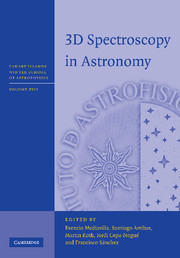Book contents
- Frontmatter
- Contents
- List of contributors
- List of participants
- Preface
- Acknowledgements
- List of abbreviations
- 1 Introductory review and technical approaches
- 2 Observational procedures and data reduction
- 3 3D spectroscopic instrumentation
- 4 Analysis of 3D data
- 5 Science motivation for integral field spectroscopy and Galactic studies
- 6 Extragalactic studies and future integral field spectroscopy science
- 7 Tutorials: How to handle 3D spectroscopy data
6 - Extragalactic studies and future integral field spectroscopy science
Published online by Cambridge University Press: 06 August 2010
- Frontmatter
- Contents
- List of contributors
- List of participants
- Preface
- Acknowledgements
- List of abbreviations
- 1 Introductory review and technical approaches
- 2 Observational procedures and data reduction
- 3 3D spectroscopic instrumentation
- 4 Analysis of 3D data
- 5 Science motivation for integral field spectroscopy and Galactic studies
- 6 Extragalactic studies and future integral field spectroscopy science
- 7 Tutorials: How to handle 3D spectroscopy data
Summary
In this set of lectures, I review recent observational progress on extragalactic studies using integral field spectroscopy (IFS) techniques, highlighting the importance of IFS for the study of the nuclear regions of nearby galaxies, of low-z active galactic nuclei (AGN) and massive star-forming galaxies, and of high-z galaxies, including lensed quasars, lensing galaxies and bright submillimetre galaxies. Emphasis is given to the study of (ultra)luminous infrared galaxies as examples of low-z systems where the physical processes relevant to the formation and evolution of galaxies can be investigated in more detail. Research projects involving future ground-based facilities and satellites are also briefly presented.
Introduction
The use of IFS for extragalactic studies has burgeoned over the past 10 years and is already becoming a standard observational technique used by several groups in many different areas. Most IFS systems (INTEGRAL, GMOS, PMAS, SAURON, SINFONI, VIMOS, etc.) allow us to simultaneously obtain spectra covering a wide spectral range over a wide field of view (up to 1 arcmin square for VIMOS). These instruments in their standard configurations provide low–intermediate spectral resolution (R of 1000 to 4000) with a relatively low angular resolution (0.5″ to 3.0″). In addition, a few IFS systems, such as OASIS on the William Herschel Telescope and SINFONI on the Very Large Telescope (VLT), can provide very high angular resolution (i.e. 0.1″) in the optical (OASIS) and near-infrared (SINFONI) when combined with adaptive optics (AO) systems.
- Type
- Chapter
- Information
- 3D Spectroscopy in Astronomy , pp. 200 - 224Publisher: Cambridge University PressPrint publication year: 2010

